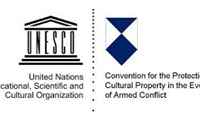
"...damage to cultural property belonging to any people whatsoever means damage to the cultural heritage of all mankind, since each people makes its contribution to the culture of the world...”
Preamble of the 1954 UNESCO Convention
The Convention for the Protection of Cultural Property in the Event of Armed Conflict was adopted at The Hague (Netherlands) in 1954, as a consequence to the massive destruction of the cultural heritage in the Second World War. It is the first international treaty of a vocation dedicated exclusively to the protection of cultural heritage in the event of armed conflict.
The Convention was adopted together with a Protocol in order to prevent the export of cultural property from occupied territory, requiring the return of such property to the territory of the State from which it was removed.
The destruction of cultural property in the course of the conflicts that took place at the end of the 1980s and the beginning of the 1990s, highlighted the necessity for a number of improvements to be addressed in the implementation of the Hague Convention. A review of the Convention was initiated in 1991, resulting in the adoption of a Second Protocol to the Hague Convention in March 1999.
Cyprus was elected as a member of the Intergovernmental Committee of the Second Protocol of the Convention for the Protection of Cultural Property in the Event of Armed Conflict for the period 2007-2011 and contributed substantially in drafting the guidelines for the implementation of the Second Protocol.
More information:
Department of Antiquities
1 Mikis Theodorakis (ex Museum Avenue)
Nicosia 1097
P.O Box 22024, 1516
Tel.: 00357-22865888, 22865873
Fax: 22303148
antiquitiesdept@da.culture.gov.cy